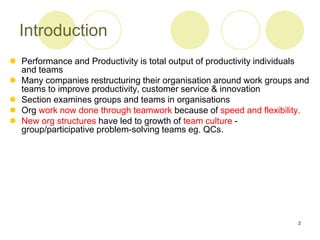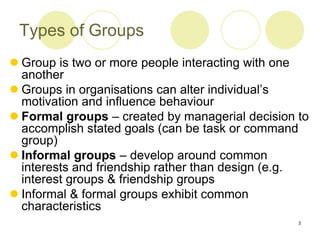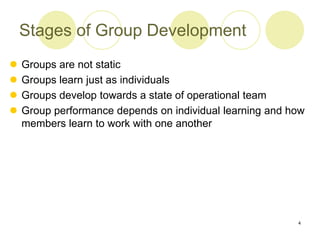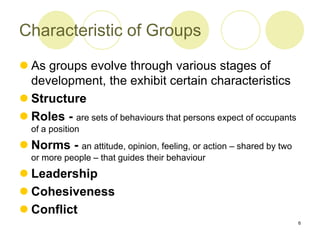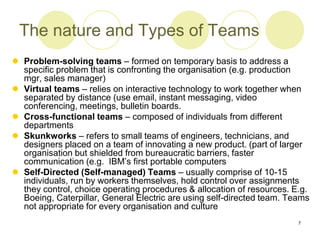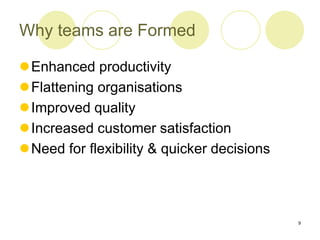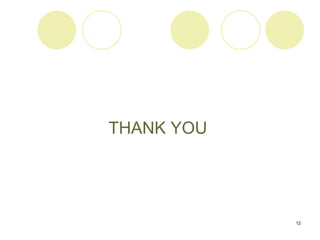Group_Dynamics_and_Team_work.ppt
- 1. 1 Management Theory & Practice GBS 550 Group Dynamics & Team work
- 2. 2 Introduction ’ü¼ Performance and Productivity is total output of productivity individuals and teams ’ü¼ Many companies restructuring their organisation around work groups and teams to improve productivity, customer service & innovation ’ü¼ Section examines groups and teams in organisations ’ü¼ Org work now done through teamwork because of speed and flexibility. ’ü¼ New org structures have led to growth of team culture - group/participative problem-solving teams eg. QCs.
- 3. 3 Types of Groups ’ü¼ Group is two or more people interacting with one another ’ü¼ Groups in organisations can alter individualŌĆÖs motivation and influence behaviour ’ü¼ Formal groups ŌĆō created by managerial decision to accomplish stated goals (can be task or command group) ’ü¼ Informal groups ŌĆō develop around common interests and friendship rather than design (e.g. interest groups & friendship groups ’ü¼ Informal & formal groups exhibit common characteristics
- 4. 4 Stages of Group Development ’ü¼ Groups are not static ’ü¼ Groups learn just as individuals ’ü¼ Groups develop towards a state of operational team ’ü¼ Group performance depends on individual learning and how members learn to work with one another
- 5. 5 Stages of Group development The Five-Stage Model ’ü¼ Stage l forming ŌĆōThis is breaking the ice, getting acquainted, time of uncertainty when members are focused on each other, being accepted, and learning more about the group. ’ü¼ Stage ll storming ŌĆō confrontation/conflict over issues of individuality and group needs, people are arguing, debating and experimenting group roles. Conflict management is the focus of attention ŌĆō power struggles take place to see who will control the group. Groups hierarchy starts ’ü¼ Stage lll norming ŌĆō development of shared expectations about groupŌĆÖs norms and roles Cohesion and group identity increases during this stage, starts to work effectively together ’ü¼ Stage lV performing ŌĆō (Mature) groupŌĆÖs energy is devoted to accomplishing goals. group structure, hierarchy, norms in place ’ü¼ Stage V adjourning ŌĆō temporary groups prepare to disband, goals have been accomplished.
- 6. 6 Characteristic of Groups ’ü¼ As groups evolve through various stages of development, the exhibit certain characteristics ’ü¼ Structure ’ü¼ Roles - are sets of behaviours that persons expect of occupants of a position ’ü¼ Norms - an attitude, opinion, feeling, or action ŌĆō shared by two or more people ŌĆō that guides their behaviour ’ü¼ Leadership ’ü¼ Cohesiveness ’ü¼ Conflict
- 7. 7 The nature and Types of Teams ’ü¼ Problem-solving teams ŌĆō formed on temporary basis to address a specific problem that is confronting the organisation (e.g. production mgr, sales manager) ’ü¼ Virtual teams ŌĆō relies on interactive technology to work together when separated by distance (use email, instant messaging, video conferencing, meetings, bulletin boards. ’ü¼ Cross-functional teams ŌĆō composed of individuals from different departments ’ü¼ Skunkworks ŌĆō refers to small teams of engineers, technicians, and designers placed on a team of innovating a new product. (part of larger organisation but shielded from bureaucratic barriers, faster communication (e.g. IBMŌĆÖs first portable computers ’ü¼ Self-Directed (Self-managed) Teams ŌĆō usually comprise of 10-15 individuals, run by workers themselves, hold control over assignments they control, choice operating procedures & allocation of resources. E.g. Boeing, Caterpillar, General Electric are using self-directed team. Teams not appropriate for every organisation and culture
- 8. What Makes Workplace Teams Effective? ’ü¼Innovative ideas ’ü¼Accomplishment of goals ’ü¼Adaptability to change ’ü¼High person/team commitment ’ü¼Being rated highly by upper management
- 9. 9 Why teams are Formed ’ü¼Enhanced productivity ’ü¼Flattening organisations ’ü¼Improved quality ’ü¼Increased customer satisfaction ’ü¼Need for flexibility & quicker decisions
- 10. 10 Review Questions ’ü¼ Imagine you are project manager of a crucial product design team to develop a schedule whereby each member takes specific role in finishing the required task. How would you accomplish the require work?
- 11. 11 Reference ’ü¼ Kolb D A, Osland J S Rubin I M, (1995) Organizational Behavior: An Experiential Approach Prentice Hall, New Jersey. Chapter 9 ’ü¼ Gibson J.L, Ivancevich J.M.,Donnely, Jr J.H, Konopaske R., (2009) Organisations: Behavior, Structure, Processes, 13th Edition, McGraw-Hill International Edition. Chapter 8
- 12. 12 THANK YOU

